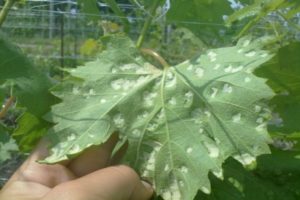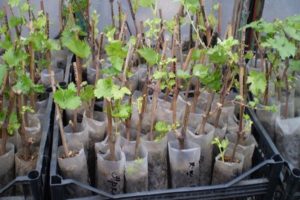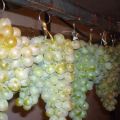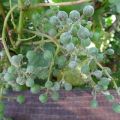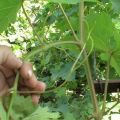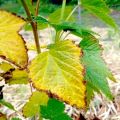How to deal with grape mites with chemical and folk remedies and how to treat
Often problems arise with the cultivation of grapes, it is not only a delicious delicacy for humans, but also for many other living organisms, which sometimes cause significant harm to the plant. One of these pests is grape mite or grape itch, which penetrates the bark or buds of a plant in winter, and destroys leaves and young vines in summer.
What is this pest?
The grape mite belongs to the class of arachnids, a superfamily of four-legged mites. It has popular names for itch, felt mite, spider mite, multiplies quickly, although it does not live long.
The parasite can only be viewed under a microscope. Its presence will be seen by some signs, although at first it can be confused with mildew disease:
- Curly leaves with burgundy tubercles.
- Younger leaves are smaller.
- Beginning in mid-summer, the green mass turns gray-white.
- Yellowing or formation of necrotic spots on the leaves.
- Young shoots are stunted and dry up.

A careful examination should be carried out along the veins of the leaf from the inside and outside, these places are most attractive to the pest.
If females hibernate under the bark of grapes, in cracks or buds, then in the spring they begin to show their activity at a temperature of 5-10 ° C. Throughout the winter period, females and males adapt to survival without leaving offspring - such individuals are called "dateoginous".
With the arrival of spring-summer, females lay inseminated and non-inseminated eggs, which go through 4 stages of the life cycle and are called "protogynous", actively multiplying during the warm season.
This type of parasite is most often transmitted with new specimens of grapes, by grafting, or carried by insects and wind. Ticks are taken into the bark for the winter on varieties with an early ripening period, on others - into the buds.
What harm can it cause?
Sucking the juice from the leaves, mites disrupt the process of photosynthesis in them, after which the leaves begin to dry out and fall off along with the remaining eggs that have not been hatched. If these leaves are not removed, then the mite can winter in the soil, and in the spring it can destroy vineyards with greater force. Other insects or birds can carry the parasite, which increases its area of distribution. Inflorescences affected by spider mites will also turn brown and fall off.
The danger of the pest is that, climbing under the bark in the cracks for the winter, it can carry on its belly the spores of fungi, which quickly grow in spring and sometimes require pruning the bush at the root.
Pest characteristics
Life expectancy is 1.5-2.5 months, during this time the female tick lays eggs up to 10 times in an amount of 20 to 300 pcs. The appearance of itching may not be immediately detected, it is very small from 0.1 mm to 0.2 mm, inconspicuous: milky yellow, cylindrical in shape. Its presence can be determined after laying the female's eggs, which she attaches from the inside of the sheet with felt threads, forming small white spots below, and a convex brown tubercle on top of the sheet.
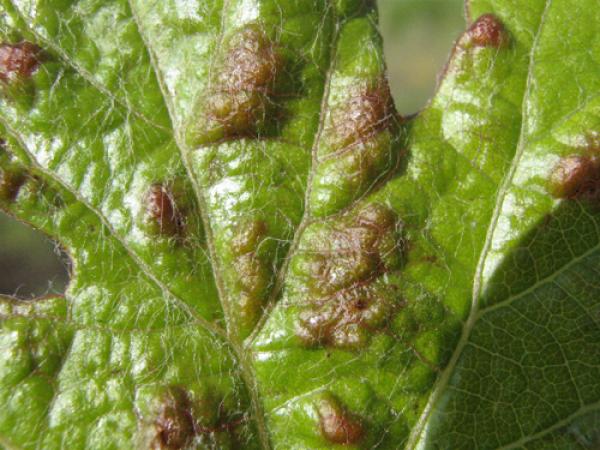
Egg larvae appear in 7-10 days and in 2 weeks grow to an adult that can lay eggs. Males differ in appearance from females, they are smaller, up to 0.14 mm.
Deformation of leaf areas occurs due to the suction of juices by mites. From April to October, grapes that are not cultivated can grow 3-10 generations, from 1 tick to 27 million, spreading throughout the bush and destroying the plant and its harvest. Due to the suction of juice from the grapes, the berries do not receive the necessary elements, some disappear, while in others the ripening and development of young vines is delayed.
There are several types of itch on grapes:
- Turkestan.
- Garden.
- Ordinary.
- Felt mite.
- Kidney.
Turkestan and common tick species can winter in fallen leaves or weeds. Garden and felt winter in the bark of grapes. Accordingly, the bud overwinters in the scales of the buds.

How to deal with grape mites
In order to effectively combat the multiplication of mites, the growing conditions of the plant must be observed. Preventive control measures are also important:
- Removal of diseased leaves, shoots and their burning.
- In autumn, harvesting cut vines and fallen leaves, burning is also recommended so that ticks are not carried by the wind.
- Clearing the area from weeds.
- Spraying on infected trees (pears, apples, plums).
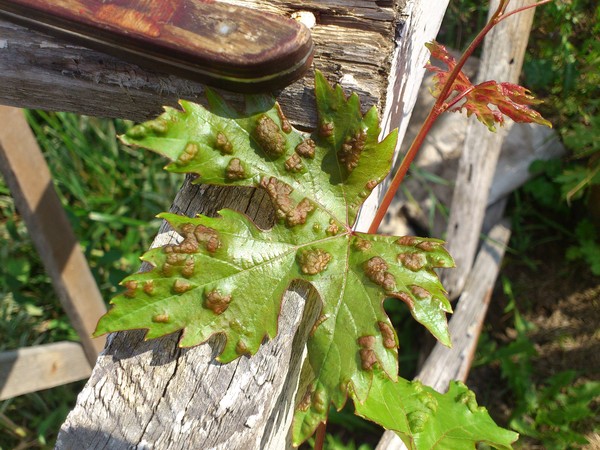
It will also be effective to treat not only your site with drugs, but also cooperation with neighbors and simultaneous processing with them.
If, nevertheless, a small amount of felt mite infection occurred on the site, then many use folk remedies. In case of severe infection of the site, chemical preparations of a gentle and aggressive action are used. To completely get rid of the parasite, it is necessary to apply a set of measures: mechanically treat the vineyards, folk and chemical means.
Use of chemicals
The preparations should be diluted in such a container so that it is convenient to handle the affected shoots and leaves. The agent must enter and penetrate the felt plaque, then the fight against the parasite will be effective.
Drugs that you can process the vineyard in spring:
- DNOC;
- "Nitrafen";
- Apollo;
- "Emulsion No. 30", No. 30a, No. 30c.

In summer they are used:
- Fozalon;
- "Keltan";
- Bi-58;
- colloidal sulfur;
- "Tedion";
- Akarin.
The entire spring-autumn period can be used:
- Actellik;
- colloidal sulfur;
- "Neoron";
- "Pliktran";
- Ortus;
- "Karbofos";
- Tiovit-Jet;
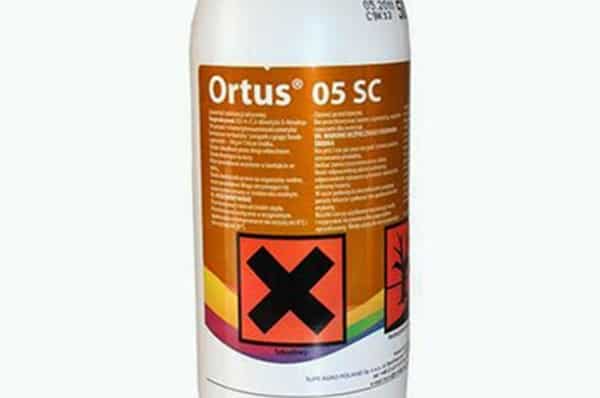
- Omite;
- "Fufanon";
- "Thunder", "Thunder 2";
- "Phyori";
- "Vertimek";
- Talstar;
- "Zolon";

- “Envidor;
- "Calypso";
- Mospilan;
- Kinmix;
- "Bazudin";
- Fozalon.
When processing drugs, you need to carefully study the instructions and the correct dosage, as well as the period of time after which you need to spray. It is also important how aggressive the drug is to surrounding plants and beneficial insects. The most aggressive are: "Actellik", "Vertimek", "Omite", but they act on the tick faster than other drugs. The most appropriate time for treatment with such drugs is the budding period.

Popular ways of fighting
Folk remedies are used for small infections of bushes.
Infusions of marigolds, onion husks, pyrethrum, calamus root, bird cherry blossom are sprayed.
Infusion of pyrethrum (Dalmatian chamomile) is part of most drugs that fight domestic and garden insects. Crushed flowers and leaves of pyrethrum (1 glass) pour boiling water (150 g) and leave for 2 days. Spray the plant after 5-7 days, leaves and green, lignified vines. To make the infusion more effective and dilute the felt threads, you can add 2 tbsp. l. alcohol, 50 g of soap solution (from laundry soap).
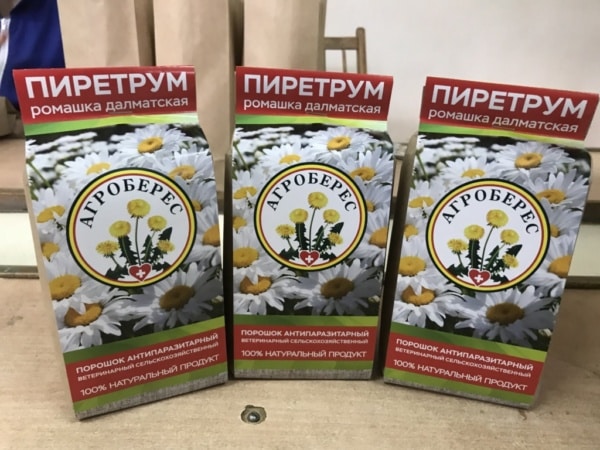
Infusion of marigolds (black shavers). 100 g of fresh flowers are poured with 100 g of warm water, respectively, for 1 kg of flowers - 1 liter of water. Insist 3 days in a dark, warm place, then filter, add 100 g of a solution of laundry soap. Spray the soil around the vineyard, vines, leaves every 10 days.
Infusion of garlic. Twist 2 large heads, fold into a liter jar, pour 0.5 liters of warm water. Insist warm for 5 days, spray once every 2 weeks.
Onion scales help fight small, inhabited plantations. You will need 200 g of husk or 400 g of old onion with husk, which is poured with a bucket of hot water (8 l), insisted for 2 days, filtered and sprayed once every 10 days. For greater efficiency, you can add an infusion of garlic and a soap solution to the solution.
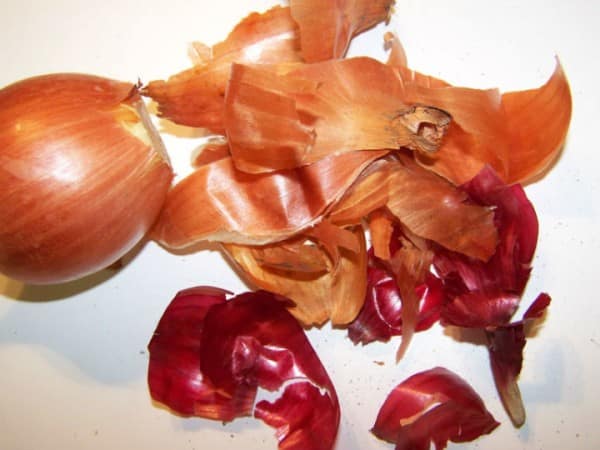
Cherry flowers (100 g) insist in 100 g of alcohol for 5 days, strain, then add soapy water and spray the grape leaves.
Calamus root is poured with boiling water in the proportion of 100 g of powder from calamus roots per 1 liter of water. In a dark place, insist for a day, strain and process the diseased plant.
Dandelion, its leaves and root, finely chopped (1 kg), pour warm water (8 l). Insist in the sun for 2 days, strain, treat diseased areas.
Decoctions of henbane, tobacco and horseradish are also used. Before using all the products, you need to put on a mask on your face and gloves, since many plants contain alkaloids that can have a toxic effect not only on an insect, but also on humans. Processing is carried out in sunny, calm weather. If it rained before the next spraying period, then the treatment must be carried out again. Before each use, fresh solutions are made, since during long-term storage, herbs lose their properties.

Prevention measures
Preventive measures should begin with sanitizing the site:
- Constant cleansing of weeds and other diseased plants.
- Apply preventive spraying with "Bi-58", Bordeaux mixture in spring and autumn.
- Proper care in compliance with all agricultural practices.
- The choice for grafting healthy plant varieties.
- Digging up the soil and spraying with insecticidal agents.

- Regular inspection of the green mass of plants.
- In the spring, summer and autumn, change the treatment preparations so that the parasite cannot adapt to one remedy.
- It is impossible to process when the berries are ripe, and 20 days before harvest.
- The vine should not come into contact with the soil.
Diseased leaves are removed, and spraying is carried out in sunny weather in the evening or morning, always in accordance with the instructions.
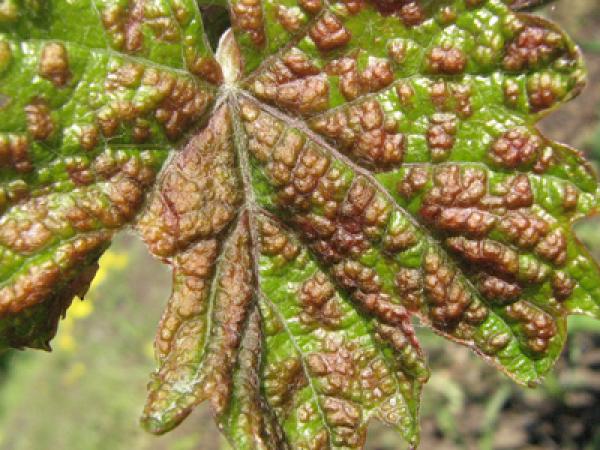
The mite is a parasite that feeds on the contents of the cells of grape leaves, which negatively affects the number of berries set and their filling with sugars, ripening. On varieties with white and yellow berries, it forms yellow bumpy spots, on red, pink, blue - brown tubercles, while the leaf plate may begin to curl around the edges. Timely measures to combat the pest can save crops and bushes from death.
